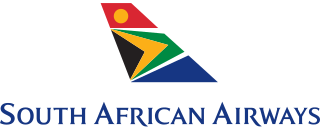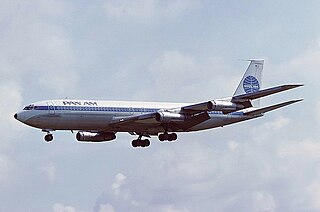
South African Airways (SAA) is the flag carrier of South Africa. Founded in 1934, the airline is headquartered in Airways Park at O. R. Tambo International Airport in Johannesburg and operates a hub-and-spoke network, serving ten destinations in Africa. The carrier joined Star Alliance in April 2006, making it the first African carrier to sign with one of the three major airline alliances.

O. R. Tambo International Airport is an international airport serving the twin cities of Johannesburg and the main capital of South Africa, Pretoria. It is situated in Kempton Park, Gauteng. It serves as the primary airport for domestic and international travel for South Africa and since 2020, it is Africa's second busiest airport, with a capacity to handle up to 28 million passengers annually. The airport serves as the hub for South African Airways. The airport handled over 21 million passengers in 2017.

Durban International Airport was the international airport of Durban from 1951 until 2010, when it was replaced by King Shaka International Airport, 60 kilometres (37 mi) to the north. The airport is co-located with AFB Durban.

South African Airways Flight 295 (SA295/SAA295) was a scheduled international passenger flight from Chiang Kai-shek International Airport, Taipei, Taiwan, to Jan Smuts International Airport, Johannesburg, South Africa, with a stopover in Plaisance Airport, Plaine Magnien, Mauritius. On 28 November 1987, the aircraft serving the flight, a Boeing 747-200 Combi named Helderberg, experienced a catastrophic in-flight fire in the cargo area, broke up in mid-air, and crashed into the Indian Ocean east of Mauritius, killing all 159 people on board. An extensive salvage operation was mounted to try to recover the aircraft's flight recorders, one of which was recovered from a depth of 4,900 metres (16,100 ft).

Nationwide Airlines was an airline based in Lanseria, South Africa. It operated scheduled domestic and international services. Its main base was OR Tambo International Airport, Johannesburg. On 29 April 2008, the airline ended operations.
Comair Limited was an airline based in South Africa that operated scheduled services on domestic routes as a British Airways franchisee. It also operated as a low-cost carrier under its own kulula.com brand. Its main base was OR Tambo International Airport, Johannesburg, while focus cities were Cape Town, flying from Cape Town International Airport and Durban, King Shaka International Airport. Its headquarters were near OR Tambo in the Bonaero Park area of Kempton Park, Ekurhuleni, Gauteng.

N'djili Airport, also known as N'Djili International Airport and Kinshasa International Airport, serves the city of Kinshasa and is the largest of the four international airports in the Democratic Republic of the Congo (DRC), It is named after the nearby Ndjili River.

American Airlines Flight 383 was a nonstop flight from New York City to Cincinnati on November 8, 1965. The aircraft was a Boeing 727, with 57 passengers, and 5 crew on board. The aircraft crashed on final approach to the Cincinnati/Northern Kentucky International Airport located in Hebron, Kentucky, United States. Only three passengers and one flight attendant survived the crash.
Airlink, is a regional airline based in Johannesburg, South Africa. Its main business is to provide services between smaller, under-served towns and larger hub airports. It has since expanded to offer flights on larger, mainline routes. The airline has a network of more than 60 routes to over 45 destinations in Southern Africa. In January 2021, it became the second-largest carrier within Africa by number of flights, and third-largest by number of seats.

Pan Am Flight 816 was an international flight from Auckland, New Zealand, to San Francisco, California, via Tahiti, French Polynesia, and Los Angeles, California. It was operated by a Pan Am Boeing 707-321B bearing the registration N417PA and named Clipper Winged Racer. On July 22, 1973, at 10:06 P.M. local time, the Boeing 707 took off from Faa'a International Airport in Papeete. Thirty seconds after takeoff, the airliner, carrying 79 passengers and crew, crashed into the sea. All occupants except 1 passenger were killed.

Trek Airways was an airline based in South Africa that operated from August 1953 until April 1994.

Pan Am Flight 812 (PA812), operated by a Pan American World Airways Boeing 707-321B registered N446PA and named Clipper Climax, was a scheduled international flight from Hong Kong to Los Angeles, California, with intermediate stops at Denpasar, Sydney, Nadi, and Honolulu. The airplane briefly appeared in the Willy Wonka and the Chocolate Factory movie in 1971. On April 22, 1974, it crashed into rough mountainous terrain while preparing for a runway 09 approach to Denpasar after a 4-hour 20-minute flight from Hong Kong. All 107 people on board perished. The location of the accident was about 42.5 nautical miles northwest of Ngurah Rai International Airport. Until the 1991 Jakarta Indonesian Air Force C-130 crash, it was the deadliest aviation accident to happen on Indonesian soil.
This is a list of aviation-related events from 2009.

MK Airlines Flight 1602 was an MK Airlines Boeing 747-200F cargo flight on a flight from Halifax Stanfield International Airport, Nova Scotia, Canada, to Zaragoza Airport, Spain. It crashed on take-off in 2004, killing the crew of 7. It was the fourth accident for MK Airlines, as well as the deadliest.

FlySafair is an international low-cost airline based in Johannesburg, South Africa. It is a subsidiary of Safair and flies to 15 destinations in Sub-Saharan Africa. The company slogan is For The Love Of Flying.

On 13 October 1976, a Boeing 707-131F, a chartered cargo aircraft operated for Lloyd Aéreo Boliviano (LAB) crashed shortly after takeoff at El Trompillo Airport, Santa Cruz de la Sierra, Bolivia, into a residential neighbourhood. All three crew on board were killed, along with 88 other fatalities on the ground, bringing the total up to 91. It is the deadliest air disaster to happen on Bolivian soil.















